by Winding Pathways | May 1, 2025 | Birds, Flowers/Grasses, Nature
A woodland stroll is outstanding in any season but is best during May’s first ten days. We always marvel at nature’s fleeting changes that happen swiftly.
Why Early May
Late April and early May are when ephemeral flowers revel in their time in the sun. That long word “ephemeral” means a short time. There’s a brief time in late April through about mid-May when the air and soil are warm but trees haven’t yet leafed out. So, sunlight streams through still naked branches to reach the ground.
Bloodroot, trout lily, anemone, Dutchman’s breeches, ginger, trillium, and May apples, among many of the woodland flowers, take advantage of this window of sunshine. They grow amazingly fast, bloom for a short time, and then seem to disappear for the rest of the year. They are there but hard to see and not in bloom during summer’s heat and winter’s chill.
-

-
An early bloomer
-

-
Trout Lily can form carpets in dappled shade.
-

-
Mayapples carpet the forest floor.
-

-
A sunny center surrounded by white petals.
-

-
Bunchberry forms a lush, carpet on moist soils.
-
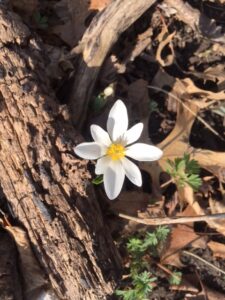
-
When broken, the stem oozes a reddish sap.
Other Delights
Enjoying wildflowers is only one of early May’s woodland delights. Another is birds.
Many of them are, like wildflowers, ephemeral but in a different way. They are migrants en route from points way south to breeding areas up north. For only a few days, often in early May, they linger to feed, rest, and sing before continuing their journey.
We always look forward to seeing migrating birds on their way north and others that come north to nest near our home. Flowers are easy to find. They can’t hide. Birds can, and often many fascinating birds are hard to spot but easy to hear as they sing in what seems like springtime joy.
-

-
Bird watching is again a joy with hearing aids.
-

-
A catbird drinks by a pool.
-
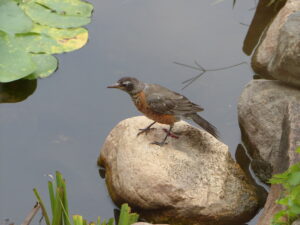
-
Keeping a wary eye, the robin cautiously gets a drink.
-

-
Hummingbirds zoom up, down, and sideways all summer. Then, head south.
-
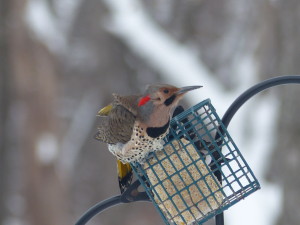
-
Winter is tough on birds so keep your feeders full.
-

-
A hooked rug by Yvonne Fellows
Modern Technology Helps
Identifying flower and bird species is a fun activity that modern technology has made relatively simple. We use phone apps to help identify plants and birds. Many are free.
Plants: SEEK is amazing. SEEK is part of an electronic world called iNaturalist. It works for many domestic plants as well as wild ones. Load the app, open it when encountering an unknown plant, take a photo, and SEEK can usually accurately identify it.
Birds: We love the Cornell University Lab of Ornithology’s Merlin Bird ID app. It includes a sound identification tool. So, when we’re in the woods, prairie or marsh and we hear birdsong we can’t identify, we turn on Merlin and select the sound feature. It identifies what’s singing. Merlin also includes photos and information on each species.
We hope you take in the annual show. Early May is the best time to be outside. Enjoy and remember.
by Winding Pathways | Dec 26, 2024 | Flowers/Grasses, Trees/Shrubs
Historic Background and Reason For Prescribed Burning
After the glaciers retreated over 9,000 years ago fires swept across much of North America, set by Native Americans and occasionally started by lightning. Fire created the vegetation and wildlife Europeans found during settlement and westward expansion.
Europeans disdained and feared fire. They suppressed it while introducing many invasive exotic plants. This has created a forest landscape of large trees with an understory of shade-loving exotic vegetation in place of former savannas.
Europeans didn’t understand nor appreciate varied ecosystems like prairies. Even as farmers and ranchers used the open lands for crops and grazing, little did they realize the importance of fires. Fires sweeping across prairies invigorate grasses and wildflowers while killing any brushy plants that try to move in.
What Fire Favors:
- It tends to favor grasslands over forests.
- It tends to create and maintain savannas.
- It tends to favor native over exotic vegetation.
- It tends to favor some native tree species over others. In general, trees that produce large nuts, such as oaks, hickories, and walnuts tend to be fire-resistant or dependent. Trees that create small seeds, such as elms, ashes, and maples tend to be fire-tender. The impact of repeated fires shifts dense woodlands to savannas dominated by oak and hickory and, in drier areas, prairies.
-

-
A cool forest burn
-

-
Burns open up sunlight for spring ephemerals.
Impact of Prescribed Burns on Prairies
Prescribed burning tends to:
- Remove insulating dead grasses, allowing the sun to warm the soil. This, favors warm season prairie plants.
- Create ash, which enriches the soil by recycling nutrients.
- Stimulate native species.
Note: burning in fall tends to favor forbs (wildflowers) while early spring burning favors prairie grasses.
Safety for Persons Conducting Burns
- Have a fire permit and adhere to its requirements.
- Wear natural fiber clothing, leather gloves, and sturdy boots.
- Understand fire behavior. See below.
- Stay out of unburned fuel and know where safe locations are. Safe locations include already burned areas, paved or gravel surfaces, and mowed lawns.
- Understand a clear burn plan as presented by the coordinator and follow directions.
- Be aware of where all people are during the burn.
- Have a cell phone with the number of the fire department programmed in.
- Have appropriate fire management tools handy and a first aid kit.
- Know about how to survive should one be “caught” by a fire.
- Be aware of “defense in depth”. (Have a second location to hold a fire should it get out of control.)
-

-

-
Mentoring younger fire managers.
Fire Behavior
Fires behave based on three factors: Fuel, Topography, and Weather.
Fires tend to burn faster:
- Upslope rather than on the flat or downhill.
- With the wind.
- With low humidity.
- With dry fine fuel.
Knowing these tenets of fire behavior helps plan burn strategy. For example, if the humidity is low, wind is moderate, and fuel is dry and fine it may be prudent to burn slowly into the wind or downslope. However, if the humidity is high and the wind is low it is likely prudent to burn with the wind, after creating a safe firebreak. These assume flat terrain.
-

-
Rich moves fire to new fuel.
-

-
Burn Against Wind
A skilled person planning a prescribed burn considers all these factors before striking a match and conducts the fire most prudently.
Conducting a prescribed burn is one of the most effective ways to restore a semblance of America’s traditional vegetation.
-

-
Pathways and prairie grasses.
-

-
Stand out of fuel.
-

-
Dark soil warms the earth.
by Winding Pathways | Dec 12, 2024 | 1080 Labyrinth Blog, Flowers/Grasses, Garden/Yard, Labyrinths
Humidity makes a huge difference when it comes to fire. So does the wind.
On mid-morning December 3, 2024, two Cedar Rapids Gazette reporters and a photographer arrived at Winding Pathways to experience a prairie burn. We’d set the date ahead of time, hoping burn conditions would be ideal. They weren’t, but we decided to give it a try.
The humidity was around 75% with barely a puff of breeze.
We aimed to burn our backyard prairie to reduce brush and encourage next year’s wildflowers. With low humidity cured prairie grass burns almost explosively, sending flames towering above the ground.
On the high-humidity morning, we struck a match and started an unenthusiastic fire that crept along the ground and only burned hot a few times. Then it died all by itself. We called it a day.
-
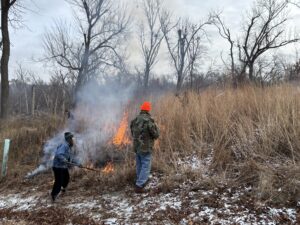
-
Olivia and Rich
-

-
Learning to pull fire.
-

-
Photographer filming
Three days later we tried again under very different conditions. The humidity was down to about 40% and a pleasant and steady southwest wind blew at around 10 miles an hour. What a difference! The fire roared across our prairie, consuming grass it had ignored three days earlier. Marion lit the prairie around her labyrinth and it also roared.
-
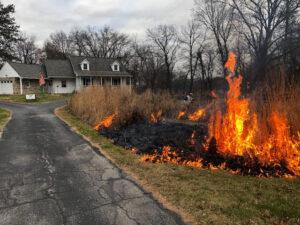
-
Low humidity burn
-

-
Fall burns allow forbs to grow.
Dry grass is especially sensitive to changes in humidity. When humidity rises grass quickly absorbs the dampness. When humidity drops, grass sheds moisture just as quickly and is ripe to burn. Wood does the same thing but much slower.
Our burning is now over for the year. We know it will stimulate an amazing array of colors next midsummer when wildflowers are in full bloom.
-

-
Colorful Flowers
-

-
Colorful flowers line the path.
-

-
Prairie grasses capture moisture.
by Winding Pathways | Sep 26, 2024 | Flowers/Grasses
Serendipitous Derecho
We sat on our back deck one early September evening remarking on the delightful wildflower progression we’ve enjoyed since early April. It is the serendipitous result of a disaster.
On August 10, 2020, a derecho’s 140-mile-an-hour wind knocked down almost all the trees. That led to days of chainsawing and hauling off firewood and brush. A few trees survived, but land that had been shady for decades was now in either partial or full sunlight.
What a change the storm made by transforming shade to sun! We planted some wildflower seeds, but the huge resurgence of flowers came from seeds that had remained dormant in the soil…..the seed bank … ..for years waiting for the right conditions to sprout.
-

-
The once shady hillside lay exposed to the sun.
-
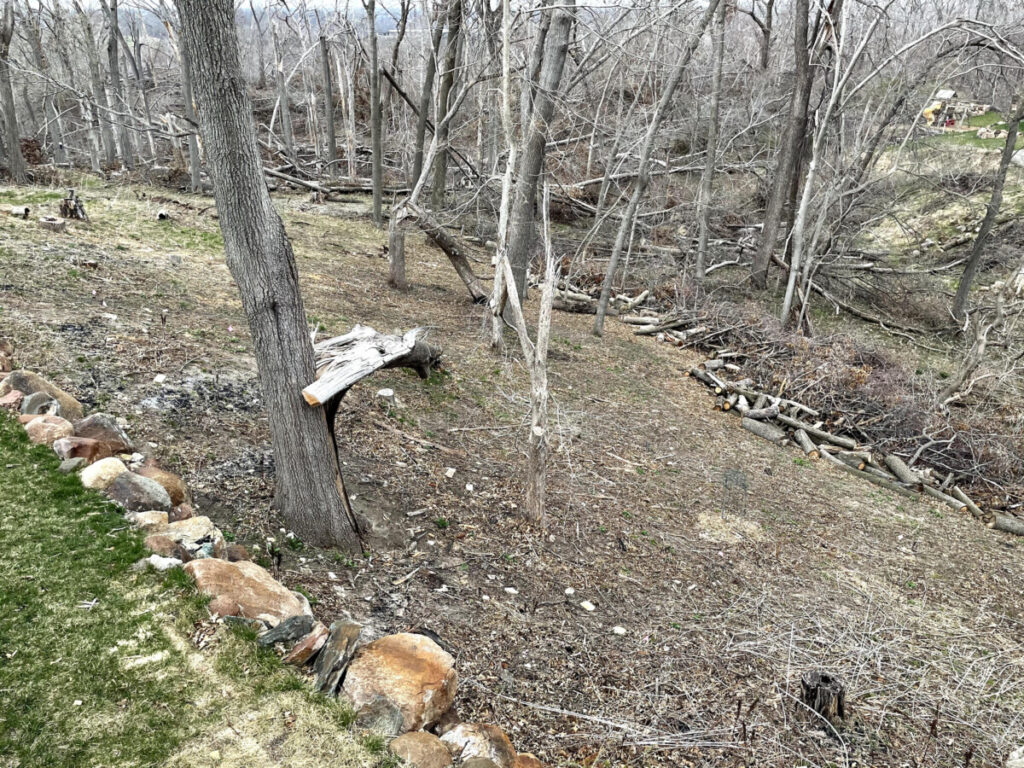
-
Bare hillside
This Growing Season
April: Spring ephemeral flowers appeared. Anemones, spring beauties, Jacob’s Ladders, ginger, and bloodroot bloomed. They are called ephemerals because they don’t last long and soon disappear.
May: Our entire former forest was carpeted with toadstool-shaped May apples. Many sprouted beautiful white flowers that are, unfortunately, mostly hidden under their large leaves. After they fruited the plants faded away to be replaced by summer bloomers.
June, July, and August: Summer flowers added color. Pale purple, yellow, and purple coneflowers and woodland sunflowers bloomed amid thriving big and little bluestem grasses. Unlike earlier flowers, these stay in bloom for several weeks.
September: Goldenrod began blooming around the first of September and was soon joined by a fresh snowfall!!!!! Well, it wasn’t really snow, but so many white snakeroots came into bloom that our former woodland looked like newly fallen snow with golden sunflowers mixed in.
White snakeroot!

The hillside glows with goldenrod and a snowy carpet of snakeroot.
It’s toxic to most mammals and once killed people, but we’re not worried. If we had a grazing milk cow she might eat snakeroots and ingest a toxic alcohol that she’d void through her milk. Years ago, people drinking her milk may have sickened or died. It’s not a problem today since cows generally don’t graze in woods, pasteurization drives off the alcohol, and store-bought milk is usually a blend from many cows. So, without worry, we enjoy our snakeroot.
We are enjoying the progression but know it won’t last. Young oaks, hackberries, black cherries, and hickories have sprouted in the area. Someday, probably long after we’ve departed, our area will again be a shady woodland.
by Winding Pathways | Sep 21, 2023 | (Sub)Urban Homesteading, Flowers/Grasses, Foraging, Nature
By September our thoughts and actions turn to autumn – fall sports, raking leaves, and cozy weekend campfires. For wildlife, especially pollinators late summer and early autumn are critical times to gather nourishment for migrations or hunkering down for winter’s scarcity.
-

-
Foraging
-

-
Feeding on nectar.
-

-
Insects find flowers.
-

-
Busy at work.
On our daily walks, often in the early morning to avoid late-season heat, we notice and appreciate late bloomers and nut abundance. Nectar is an important food supply for pollinators who busily forage among flowers. When the weather cools, pollinators are out later in the day as the sun warms the air. Remember, there is a “night shift” of pollinators, too, who need flowers to feed from.
Here are some late-blooming flowers we have seen on walks or that we nurture in our yard.
-

-
cultivated flowers work, too.
-

-
Roadside blooms are important.
-

-
Color contrast.
-

-
Some flowers prefer low lying areas to grow.
by Marion Patterson | Apr 13, 2023 | Amphibians/Reptiles, Birds, Flowers/Grasses, Hearing, Nature, Wonderment
A Season of Variables
After a drab March “look up, look down, listen” season is here. It’s exciting and frustrating. Always something to see and hear and things we miss, too.
What is look up, look down, listen? Well, when we walk in woods and prairies, we’re always attuned to nature’s beauty and curiosities. In the Northern Hemisphere April and May force challenges and delights, as the earth turns toward the sun. Its warmth stimulates new life while welcoming arrivals from down south.
Here in Iowa, like much of the United States, bird migration rises through April and peaks in early May. Woods, wetlands, and prairies are filled with bird species we haven’t seen since last year.
Look Up!
“Look up,” Marion remarked on one April walk last year. She spotted the first Rose Breasted Grosbeak of the season. He was perched on a thin branch high in a sycamore tree. As we walked along, we kept looking up to spot other new arrivals. They added color and song to those of cardinals, chickadees, and woodpeckers who are our neighbors all year.
-

-
A catbird drinks by a pool.
-

-
The brown creeper blends in with tree trunks.
Look Down!
After admiring the Grosbeak and moving on, I said, “look down.” We had been paying so much attention to birds up in the trees that we almost trampled a Dutchman’s Breeches, a delicate white wildflower with petals shaped like old-time Dutch pants. Looking down revealed spring beauties, Mayapples, hepatica, and anemones. Some were not quite in bloom and a few had gone by, but most were in their spring glory.
-

-
Early spring flowers
-

-
Reaching for the sun
-

-
Dutchman’s Britches
-

-
Snow Trillium
Shhhh! Listen
Passing a low wetland, we both paused to hear the songs of the chorus frogs and peepers that greet listeners each spring between the vernal equinox and Easter.
So, what do we do on a spring walk? Look up or down or listen? All of these. It is the best time of year to enjoy beauty clinging to the soil, singing from treetops, and chorusing from ephemeral pools.
Make Nature ID easier with Apps
Spotting birds hiding invisibly in tangles of branches and vines is challenging. What’s in that thicket singing? Thanks to the Cornell Laboratory of Ornithology, we turn on our Merlin app, point the phone where the songs originate, and learn who’s singing. Merlin is easy to download from the app store. Sometimes we are lucky and watch migratory birds close at hand.
Some people even lure birds in with treats that are eagerly consumed by arriving birds.
Wildflowers cannot hide but can be confusing. We sometimes use an app called SEEK to identify ones that are mysterious to us. SEEK is also easy to download from the app store and can also help identify trees, weeds, and other living things.
Look up, look down, listen! season may be the very best time to be outside. We love it.














































